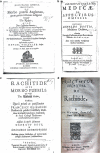Rickets before the discovery of vitamin D
- PMID: 24466409
- PMCID: PMC3899557
- DOI: 10.1038/bonekey.2013.212
Rickets before the discovery of vitamin D
Abstract
The story of rickets leading to the discovery of vitamin D is an extraordinary tale, spread over many centuries and involving some remarkable characters with much speculation and a few mysteries, before reaching an exciting climax. It would be wrong to credit a single person as discovering rickets or being the first to describe its features, for reasons that will be set out here. Yet the emergence of the term 'rickets' is as important as the discovery of vitamin D itself and the possible causes of its deficiency. It permitted identification of a hitherto ill-defined disease entity, typically occurring in infants and children. It also provided a way for deciding if features of diseases that had been described earlier in the history of medicine could be seen as the symptoms and signs of related conditions.
Conflict of interest statement
The authors declare no conflicts of interest.
Figures



References
-
- Lee T. Historical notes on some vitamin deficieny diseases in China. In: Brothwell D, Sandison AT (eds). Diseases in Antiquity. Springfield: Charles C Thomas, 1967, pp 417–422.
-
- Temkin O. How one should make the infant sit up and endeavor to walk.Soranus Gynecology. Baltimore: Johns Hopkins Press, 1991, pp 115–116.
-
- Ruhrah J. Soranus of Ephesus Pediatrics of the Past. New York: PB Hoeber, 1925, pp 4–11.
-
- Theodosius Baptista Epistola 42, 1553 See Hess AF Rickets. London: Kimpton, 1930, p 25.
-
- Sprengel C. Toms 1V Lib V1 De Cachexis Caput V11 De rachitide Lipsae. 1819, p 560.
Publication types
LinkOut - more resources
Full Text Sources
Other Literature Sources
